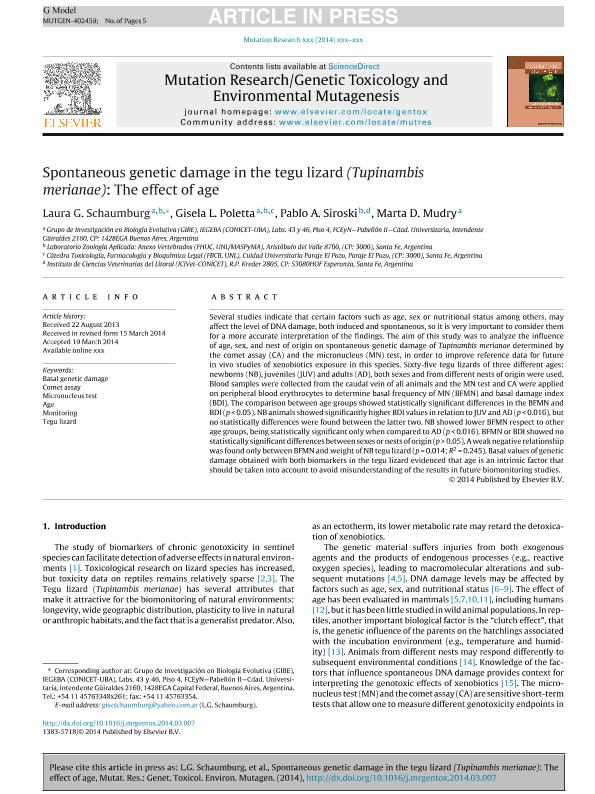Mostrar el registro sencillo del ítem
dc.contributor.author
Schaumburg, Laura Gisela

dc.contributor.author
Poletta, Gisela Laura

dc.contributor.author
Siroski, Pablo Ariel

dc.contributor.author
Mudry, Marta Dolores

dc.date.available
2017-07-12T21:36:30Z
dc.date.issued
2014-05
dc.identifier.citation
Schaumburg, Laura Gisela; Poletta, Gisela Laura; Siroski, Pablo Ariel; Mudry, Marta Dolores; Spontaneous genetic damage in the tegu lizard (Tupinambis merianae): The effect of age; Elsevier; Mutation Research. Genetic Toxicology And Environmental Mutagenesis; 766; 5-2014; 5-9
dc.identifier.issn
1383-5718
dc.identifier.uri
http://hdl.handle.net/11336/20297
dc.description.abstract
Several studies indicate that certain factors such as age, sex or nutritional status among others, mayaffect the level of DNA damage, both induced and spontaneous, so it is very important to consider themfor a more accurate interpretation of the findings. The aim of this study was to analyze the influenceof age, sex, and nest of origin on spontaneous genetic damage of Tupinambis merianae determined bythe comet assay (CA) and the micronucleus (MN) test, in order to improve reference data for futurein vivo studies of xenobiotics exposure in this species. Sixty-five tegu lizards of three different ages:newborns (NB), juveniles (JUV) and adults (AD), both sexes and from different nests of origin were used.Blood samples were collected from the caudal vein of all animals and the MN test and CA were appliedon peripheral blood erythrocytes to determine basal frequency of MN (BFMN) and basal damage index(BDI). The comparison between age groups showed statistically significant differences in the BFMN andBDI (p < 0.05). NB animals showed significantly higher BDI values in relation to JUV and AD (p < 0.016), butno statistically differences were found between the latter two. NB showed lower BFMN respect to otherage groups, being statistically significant only when compared to AD (p < 0.016). BFMN or BDI showed nostatistically significant differences between sexes or nests of origin (p > 0.05). A weak negative relationshipwas found only between BFMN and weight of NB tegu lizard (p = 0.014; R2= 0.245). Basal values of geneticdamage obtained with both biomarkers in the tegu lizard evidenced that age is an intrinsic factor thatshould be taken into account to avoid misunderstanding of the results in future biomonitoring studies.
dc.format
application/pdf
dc.language.iso
eng
dc.publisher
Elsevier

dc.rights
info:eu-repo/semantics/openAccess
dc.rights.uri
https://creativecommons.org/licenses/by-nc-sa/2.5/ar/
dc.subject
Basal Genetic Damage
dc.subject
Comet Assay
dc.subject
Micronucleus Test
dc.subject
Age
dc.subject
Monitoring
dc.subject
Tegu Lizard
dc.subject.classification
Otras Ciencias Biológicas

dc.subject.classification
Ciencias Biológicas

dc.subject.classification
CIENCIAS NATURALES Y EXACTAS

dc.title
Spontaneous genetic damage in the tegu lizard (Tupinambis merianae): The effect of age
dc.type
info:eu-repo/semantics/article
dc.type
info:ar-repo/semantics/artículo
dc.type
info:eu-repo/semantics/publishedVersion
dc.date.updated
2017-07-07T20:07:07Z
dc.journal.volume
766
dc.journal.pagination
5-9
dc.journal.pais
Países Bajos

dc.journal.ciudad
Amsterdam
dc.description.fil
Fil: Schaumburg, Laura Gisela. Consejo Nacional de Investigaciones Científicas y Técnicas. Oficina de Coordinación Administrativa Ciudad Universitaria. Instituto de Ecología, Genética y Evolución de Buenos Aires. Universidad de Buenos Aires. Facultad de Ciencias Exactas y Naturales. Instituto de Ecología, Genética y Evolución de Buenos Aires; Argentina. Universidad Nacional del Litoral. Facultad de Humanidades y Ciencias. Departamento de Ciencias Naturales. Laboratorio de Zoología Aplicada: Anexo Vertebrados (FHUC-UNL/MASPyMA); Argentina
dc.description.fil
Fil: Poletta, Gisela Laura. Universidad Nacional del Litoral. Facultad de Humanidades y Ciencias. Departamento de Ciencias Naturales. Laboratorio de Zoología Aplicada: Anexo Vertebrados (FHUC-UNL/MASPyMA); Argentina. Consejo Nacional de Investigaciones Científicas y Técnicas. Oficina de Coordinación Administrativa Ciudad Universitaria. Instituto de Ecología, Genética y Evolución de Buenos Aires. Universidad de Buenos Aires. Facultad de Ciencias Exactas y Naturales. Instituto de Ecología, Genética y Evolución de Buenos Aires; Argentina. Universidad Nacional del Litoral. Facultad de Bioquímica y Ciencias Biológicas; Argentina
dc.description.fil
Fil: Siroski, Pablo Ariel. Consejo Nacional de Investigaciones Científicas y Técnicas. Centro Científico Tecnológico Conicet - Santa Fe. Instituto de Ciencias Veterinarias del Litoral. Universidad Nacional del Litoral. Facultad de Cs.veterinarias. Instituto de Ciencias Veterinarias del Litoral; Argentina. Universidad Nacional del Litoral. Facultad de Humanidades y Ciencias. Departamento de Ciencias Naturales. Laboratorio de Zoología Aplicada: Anexo Vertebrados (FHUC-UNL/MASPyMA); Argentina
dc.description.fil
Fil: Mudry, Marta Dolores. Consejo Nacional de Investigaciones Científicas y Técnicas. Oficina de Coordinación Administrativa Ciudad Universitaria. Instituto de Ecología, Genética y Evolución de Buenos Aires. Universidad de Buenos Aires. Facultad de Ciencias Exactas y Naturales. Instituto de Ecología, Genética y Evolución de Buenos Aires; Argentina
dc.journal.title
Mutation Research. Genetic Toxicology And Environmental Mutagenesis

dc.relation.alternativeid
info:eu-repo/semantics/altIdentifier/doi/http://dx.doi.org/10.1016/j.mrgentox.2014.03.007
dc.relation.alternativeid
info:eu-repo/semantics/altIdentifier/url/http://www.sciencedirect.com/science/article/pii/S1383571814000849
Archivos asociados
